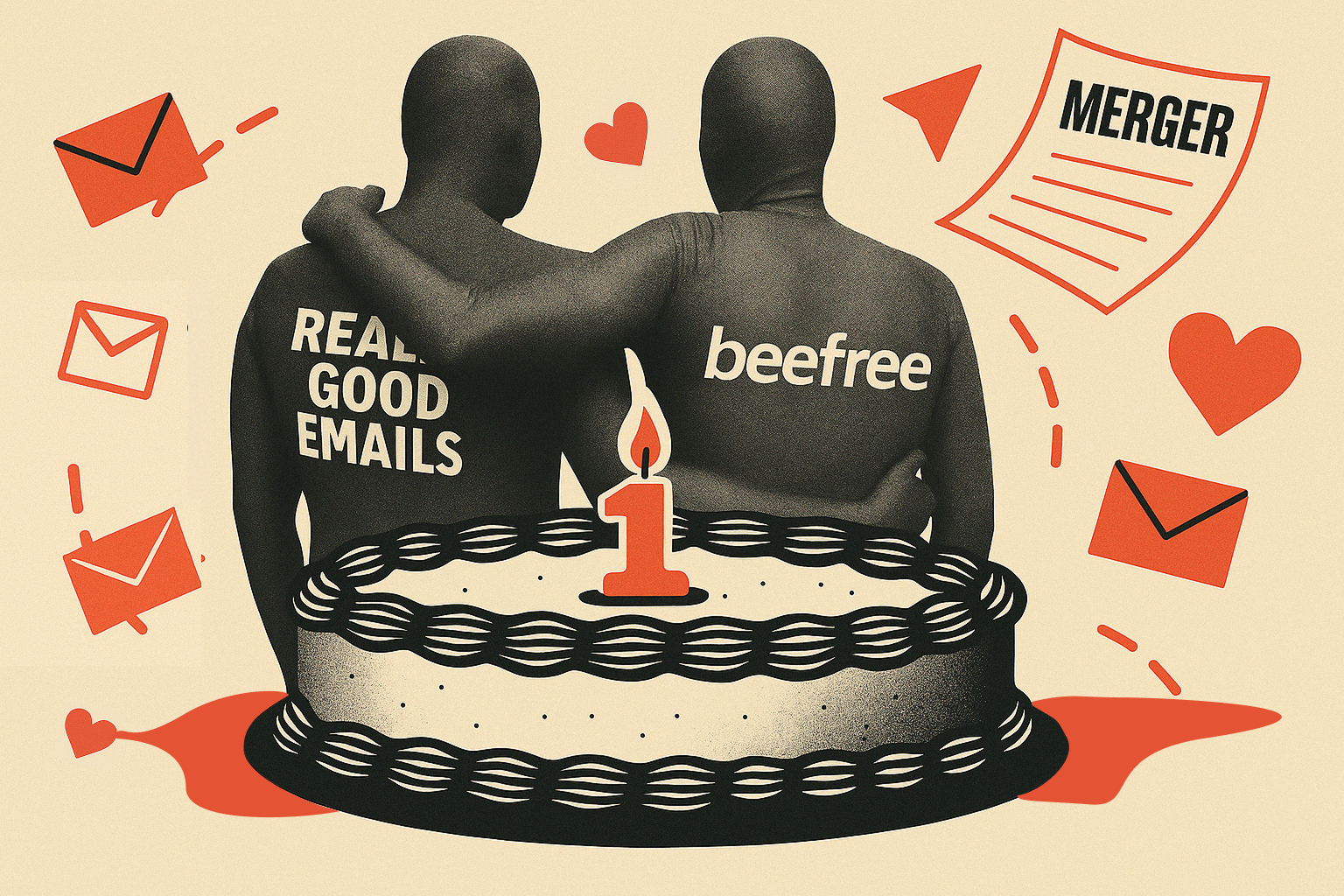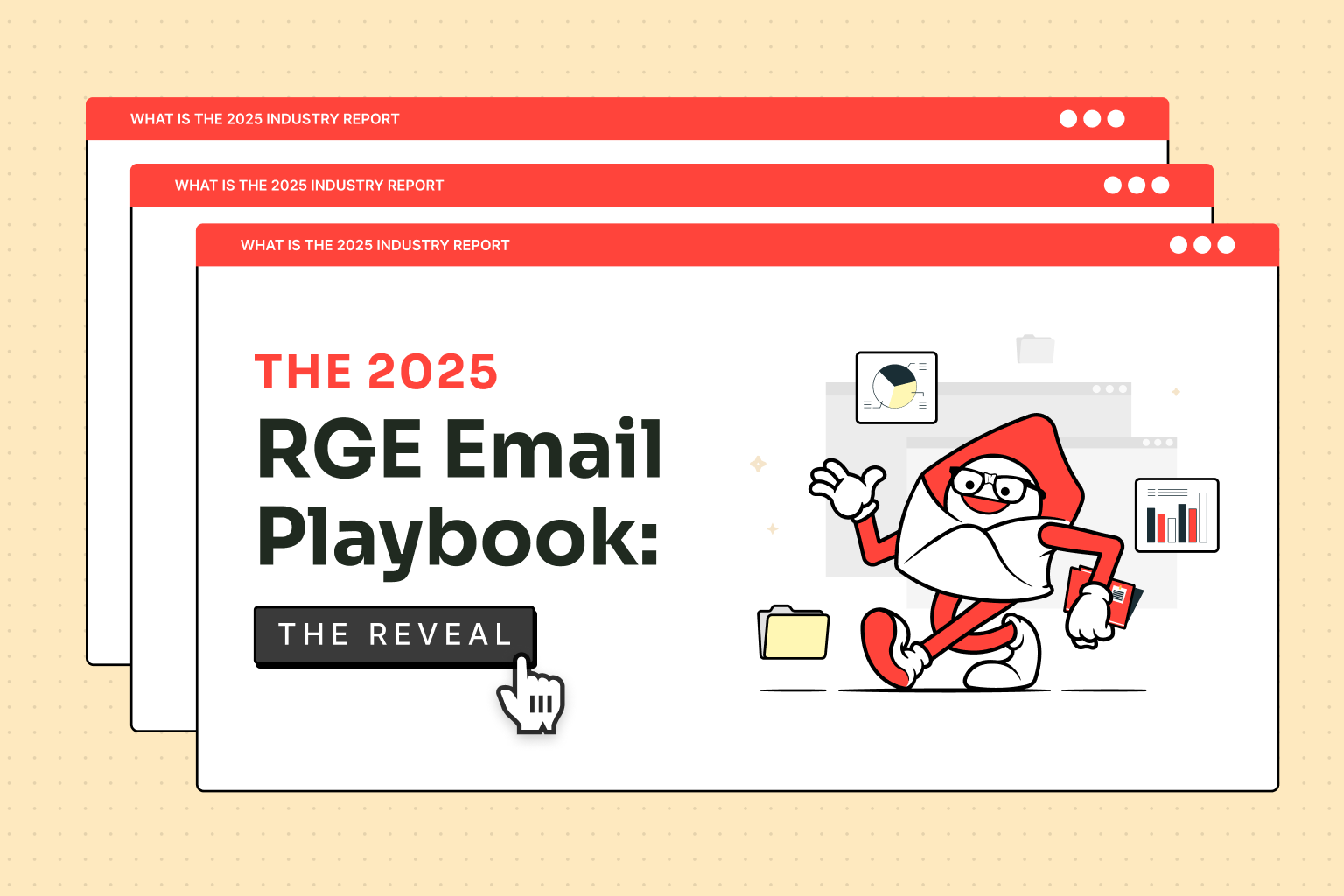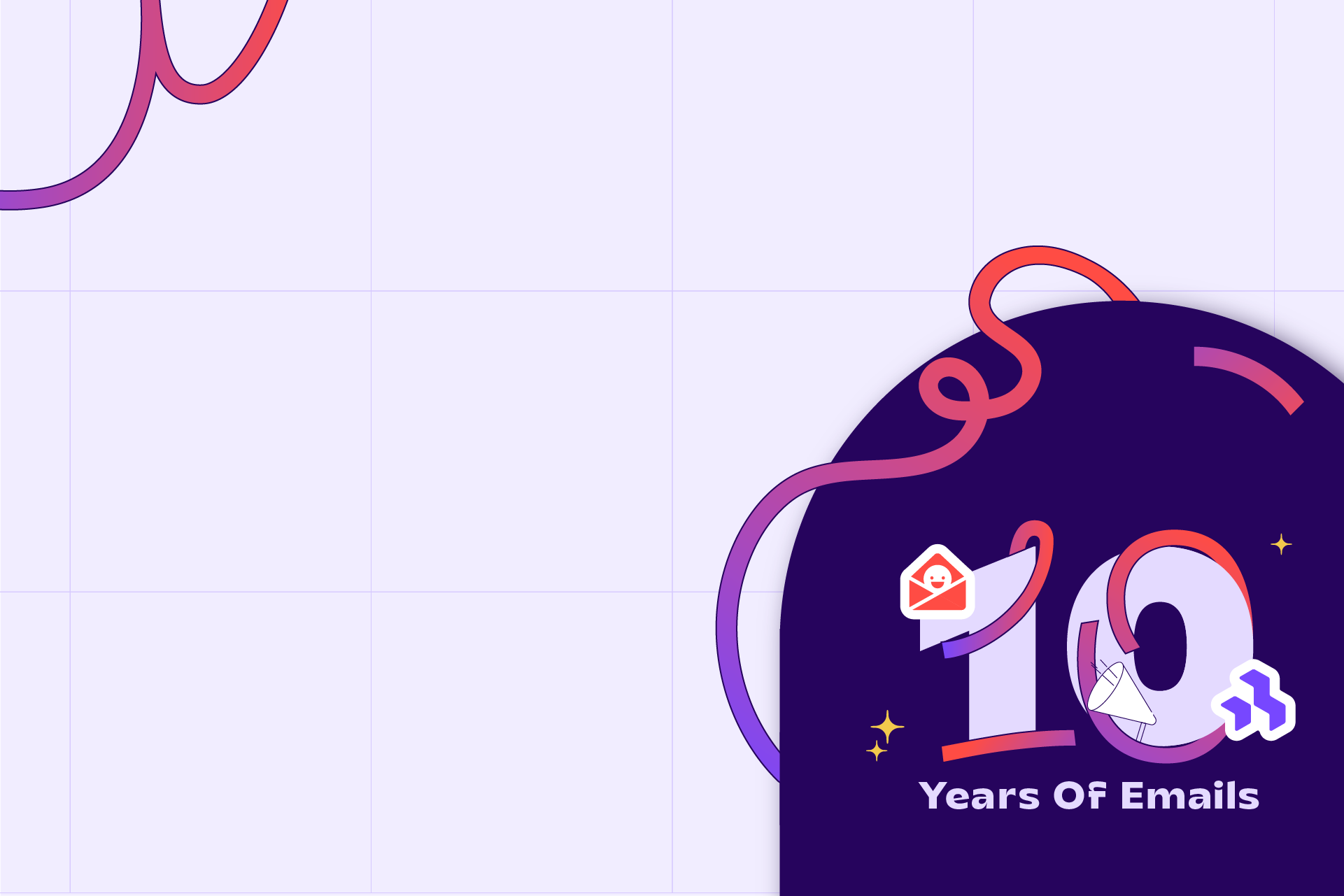Mike Nelson: Our panelists are also joining from different locations. I'm just south of Nashville. I'll be doing a lot of the talking today, so apologies if you don’t like the sound of my voice. Next on my screen is Kelsey.
Kelsey Yen: Hi, I'm in Portland, Oregon, on the West Coast.
Mike Nelson: Then we have Naomi.
Naomi West: Hey, I’m Naomi. I’m in Vancouver, in the Pacific Northwest. Would love to see a couple of Canadian flags in the chat.
Mike Nelson: And last, we’ve got Tylor.
Tylor Loposser: Hi, I’m in Nashville too.
Mike Nelson: We’re kind of next-door neighbors. Not literally, but we’re about 20 minutes apart. Honestly, we probably should have just done this from the same office.
Tylor Loposser: We should, yeah.
Mike Nelson: Cool. Thanks for joining, everybody. If you're here, you're here to learn about what's going on in the industry and get a little background. You're probably wondering where this came from, since Really Good Emails started. We've been taking a lot of surveys, and I realized that when those surveys come out from ESPs like Adobe or Salesforce, they're very user-centric. They don't really focus on what's happening in the industry or how it's evolving. They mostly care about how people are using their own software or technology.
And so in 2016/2017, I don’t know, it was a long time ago, I forgot the date, but we started this little survey. It’s grown into a pretty extensive survey where we are looking at what’s going on in the industry, how people care about email, what they’re doing in email, what tools they’re using, what they hate most about email, all that jazz. So we're gonna go over some of the trends that have been happening throughout the years. What’s going on this year? Where does the optimism or pessimism come in? We’ve got panelists to share their opinions and their stats. They’re from email, they’ve been in email for a long time, like I have. Kelsey, how long have you been in email?
Kelsey Yen: Probably about eight years now.
Mike Nelson: Tylor?
Tylor Loposser: Almost a decade.
Mike Nelson: Naomi?
Naomi West: Yeah, I'm with Tylor. 2015. So, depending on the month, it’s nearly a decade.
Mike Nelson: Okay, so I’m like the grandpa because I joined back in 2006. Old hat over here. We’ve been doing this for a while. We’ve seen the industry over a long period. We’ve seen the ups and downs, people come and go. That’s what we’re going to look at today, and the focus is really on you.
Hopefully, everyone joining may have taken the crazy quiz or survey we sent out. Our sample size was almost 1,700 people, which is 41 percent more than last year. It took an average of about 20 minutes to complete. So again, thank you to everyone who used their lunch breaks or skipped their lunch breaks and said, “Screw this, I’m going to work on this survey instead of doing my job.” We love that. So thanks for coming.
I showed this screen, and we talked about it at UNSPAM a couple of weeks ago, but this is just to show the data nerds that this is a statistically significant sample size. Nobody can say, “Well, your sample size is five people.” No, it’s a pretty large group that gave us this information. So, thank you for doing that and for spending that time with us. We clearly have a lot of time on our hands, and yes, we’re still working here.
We’ll be in this webinar for the next 45 to 50 minutes. Alright, other than the three or four people you see on your screen today, there are a lot of us in email. So now we’ll dive into who makes email cool and who creates the emails. Let’s meet them: part-time versus full-time.
 Mike Nelson: Kelsey and Tylor, did you guys start part-time, or did you go into email full-time?
Mike Nelson: Kelsey and Tylor, did you guys start part-time, or did you go into email full-time?
Tylor Loposser: Full-time.
Mike Nelson: So from the beginning?
Tylor Loposser: Yeah, and that was all my work. I was an email designer and developer, and the only thing I touched was email.
Mike Nelson: Dang. Kelsey?
KelseyYen: Wow. I started part-time, doing lots of different things, and then a little bit of email here and there until I realized that email was where it was at. So yes, I started part-time and now I’m full-time.
Mike Nelson: Like I said, you didn’t choose email. Email chose you, right?
Kelsey Yen: It sure did.
Mike Nelson: Naomi, when and where did you start?
Naomi West: I started part-time. I was working as a receptionist at a legal recruiting company and found a part-time marketing gig on AngelList. I thought I had fully discovered marketing automation. I couldn’t believe people weren’t talking about it. I came across Autopilot, which I think may have been renamed to Border. I had a full moment while sitting at my receptionist job, feeling over-employed and thinking, “Oh my God, I can’t believe this exists.”
Mike Nelson: I started in a part-time role as well, originally in SEO and PPC. I’ve always been a bit of a nerd and have a real love for Excel spreadsheets, optimization, and growth hacks. Then I discovered email and gradually transitioned into a full-time role over the years. If you look at the data, part-time was the norm when we started. It made up the majority in 2016, 2017, and 2018. Close to 70 percent of participants during that period were part-timers.
Now, as of this year, we’ve crossed a new threshold where the majority of roles are full-time. There are more people actively building and managing email than we’ve ever seen in the history of the industry. So what does that tell us? It tells us that email has become significantly more powerful and more complex. It likely delivers a stronger return on investment, or at the very least, more measurable and recognized ROI. The value has always been there, but now more companies are acknowledging and investing in it.
There is also far more strategy involved. Email is an owned channel, unlike social media. You might have a dedicated social media manager who needs to be constantly available, handling everything from technical issues to customer complaints about missed flights or delayed responses. With other marketing channels, it’s often possible to bounce between tasks like designing a flyer or launching a campaign. But email has evolved into a role that requires full-time focus. As we’ve heard from several people today, many of us started part-time and later moved into full-time positions. That shift is reflected clearly in the data, and it highlights the growing complexity and importance of email in today’s marketing landscape.
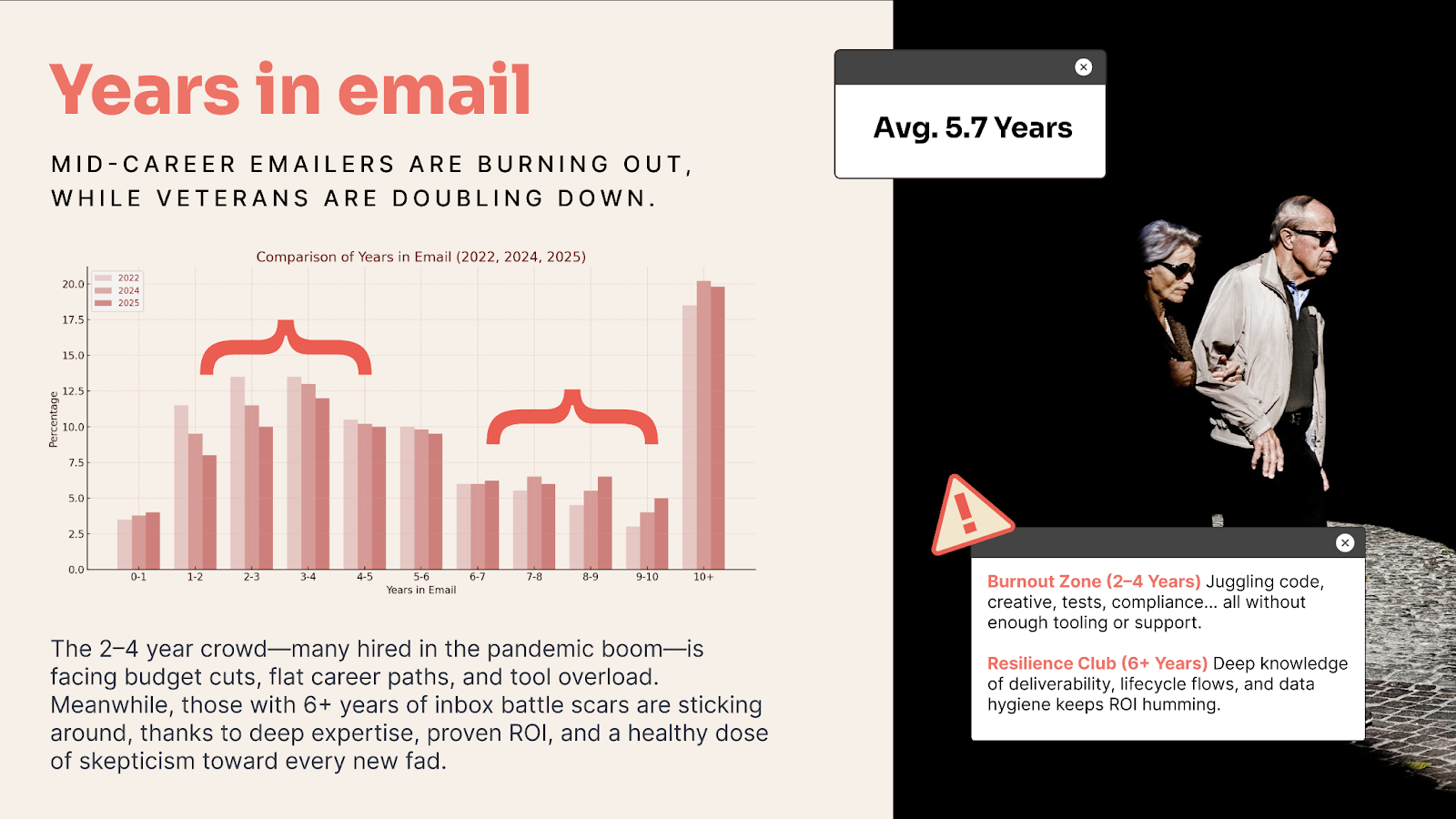
Mike Nelson: All right. It has increased by 40 percent since 2018, so that's many years of growth in email. We just talked about how long we've been in email. The average is about six years at this point. What you see here on the screen is two tranches. You see a group of people who joined before the pandemic, COVID. Hopefully, that word doesn't give you PTSD like it does for me, with three children in my house during that time. Then you have a group of people who have been here for six to ten years or more.
Ten plus is the long tail. If you've been in email for more than ten years, you have likely grown and stayed in the field. Somewhere in that two-to-four-year range, if you look at past years, you’ll see that people who came in during or after the pandemic tend to burn out. Those who were here before the pandemic tend to stick around. Naomi, why do you think that is? Why do you think people are more gung-ho the longer they've been in email?
Naomi West: Maybe they just get pigeonhole into it. I don't know. For me, the longer I’ve stayed in email, the more I’ve enjoyed it. I feel like with email, there’s always something more to learn, whether it's digging deeper into code, experimenting with dynamic content, or refining personalized segmentation. There’s always something new. That’s how I see it.
I almost think of email like a game of Super Mario. You’re running along, and a mushroom pops out. Then you hit it, and you grow. That’s how I feel when I get small email wins. I don’t know if other people feel the same way. It’s kind of an odd analogy, but that’s why I enjoy it.
Mike Nelson: Yeah, I think that’s true. When I think about the people who have stayed in email versus those who joined and then left, I tend to split them into two types. This is just a generalization, of course, and doesn’t apply to everyone. If you were in the industry before the pandemic, you saw the complexity increase over time, and your career evolved along with it. You saw the introduction of things like JSON, attributes, and user-related objects. You experienced the rise in CRM complexity and all the data connected to individual users. You figured out new ways to segment and do advanced things.
People who joined after the pandemic may have looked at all of this and thought, “This is a lot.” Like, “I have to learn everything right now.” They were expected to hit the ground running. There are so many tools available that it's hard to know where to begin. And on top of that, they’re expected to send six, eight, even twelve emails a week. I don’t know how many you’re sending, but the people who have been around longer have ramped up to that level. Over time, we’ve conditioned ourselves, while newer folks were thrown straight into it.
So again, that’s just a hypothesis. But I do think it’s interesting. The longer you’ve been in email, the more you tend to love it. For people just starting out, it can feel overwhelming. We’ve also noticed something we call the "trough of sorrows," which may or may not show up in this dataset. Around year two, people start to wonder, “Why am I doing this? Why am I here? What else could I be doing?” But by year four, people start saying, “Oh, I actually like this.” If you can push through that middle stage, you tend to stick around.
Our hypothesis is that email today demands more experience than it used to. Alright, let’s move into roles.
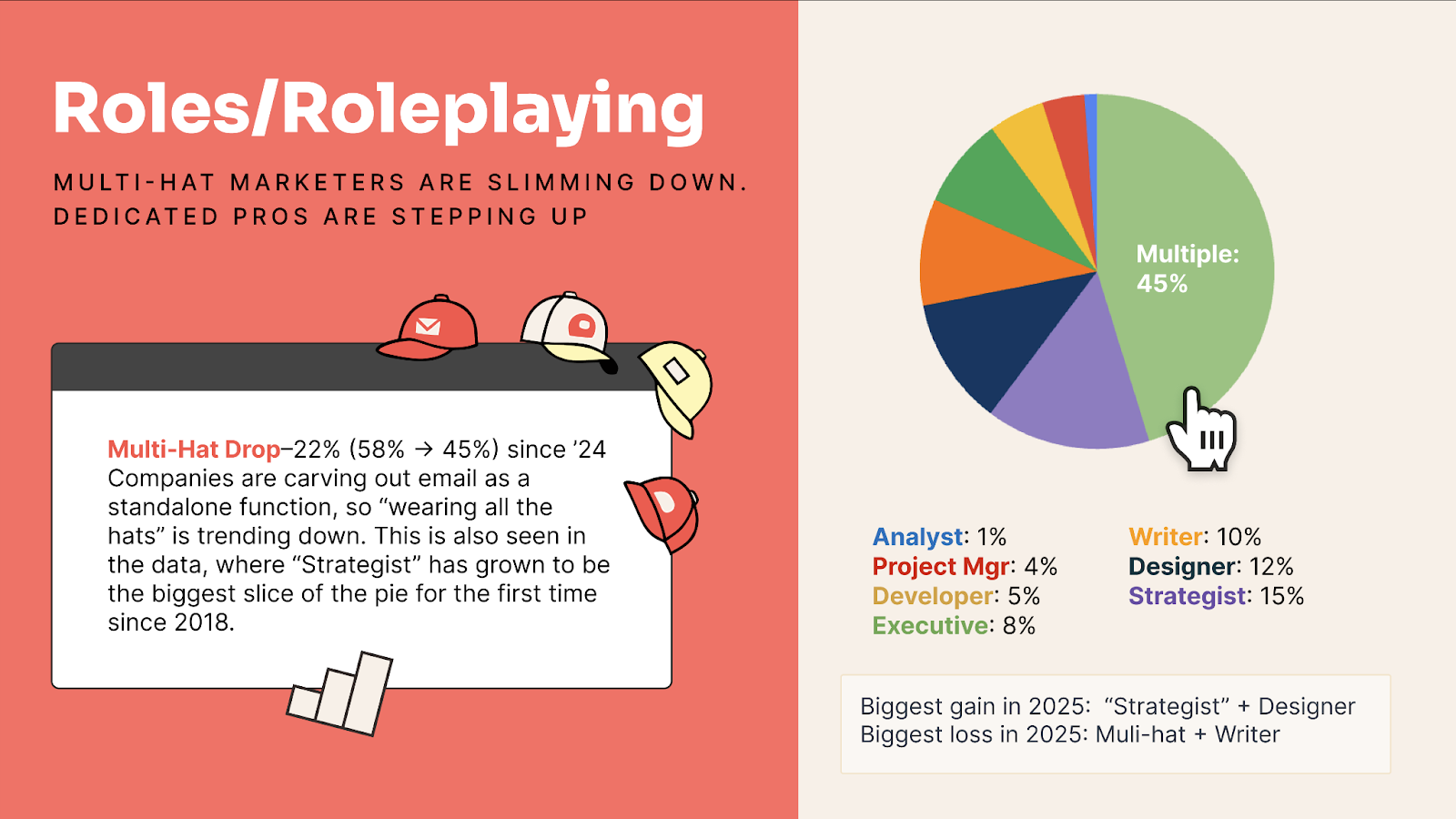
Mike Nelson: Tylor, back to you. You said you started as an engineer and designer. You've worn a lot of hats over the years. Can you tell us how you went from where you were to where you are now?
Tylor Loposser: Yeah, so I guess my burnout in email led me to want to get more involved in the marketing side and in other stages of the buyer or user journey. Going back to what we talked about earlier, I think one big reason creatives enjoy working in email is that it gives you fast feedback. You can see the results of your work within days. You can log into your platform and see how it’s performing. What do people like? What don’t they like? You can use that insight to inform your next design. Sometimes you don’t get that kind of feedback loop with other media. So I think that’s a major reason creatives love email.
You get a clear response that tells you whether or not your work is effective. But after spending time on email, I wanted to understand more about what happens before and after the email. I wanted to know how I could influence other parts of the journey. I wanted my work to matter across the whole story. So expanding my role meant expanding the kinds of interactions I had.
I started learning more about UI and UX, direct mail, social media, and other related areas. This expanded my skill set and the reach of my work. I could still contribute as a creative, but now in more areas.
Mike Nelson: Yeah, and we jumped right into this because I don’t like starting with long intros and all that. But for context, Tylor is from Zeta Global, which is a major ESP. He’s done a lot of different things. Before that, you were at Campaign Monitor, right?
Tylor Loposser: Yeah.
Mike Nelson: So he’s worked with a lot of clients. Naomi is currently at Customer.io and Parcel. She works closely with developers focused on email and coding, which is super cool. If you look at our audience, only about 5 percent are developers. So that’s a labor of love, Naomi. I love that you're dedicating your work to that 5 percent. All of us here have grown up in email, and we know how to code. We know how to fix the code when something needs to behave a certain way.
And just to note, the developer percentage actually dropped from 6 percent last year to 5 percent. So it didn’t change much. But what do you think about that dedicated developer role, compared to developers who are juggling other responsibilities? We’ll talk about AI later, but what are your thoughts on this, Naomi?
Naomi: I think developers are incredibly valuable. The things I see developers come up with constantly leave me amazed. Tom Lin, you're in the audience right now, and every time I see what you're working on, I think, this is so cool. It’s incredible to know someone so skilled in HTML and beyond.
And I think it’s really exciting to work on a tool that is so niche and specialized. But I also have to remember that 45 percent of the group represented in this chart are probably wearing 17 different hats. I think a good number of them have to jump into code from time to time. So we’re all out here doing good work. We’re trying.
Mike Nelson: Yeah. And Kelsey, you're representing Really Good Emails on my team. We originally hired you on the Beefree side, and then I said, hey, you're going to be on my team. You're a lifecycle manager, but you also do several other things. You code the emails, you do some design, and you write copy.
Why do you think the number of people wearing multiple hats has decreased since last year? What’s your take?
Kelsey: I come from a multi-hat background and really enjoy doing a variety of things. But in today’s environment, there’s so much more that can be done with email that people need to be more specialized to make an impact and drive meaningful change.
It used to be that you could handle everything yourself. Email was kind of an afterthought — like, “Oh yeah, we should probably send an email.” But now, because email has grown so much and become more complex, you need to be more strategic and focused. So I think the decrease makes sense. Just sending an email isn’t enough anymore, and I think we’re seeing that reflected in how teams are structured.
Mike Nelson: Definitely. And as Ben pointed out in the comments, if you're a smaller business, you probably don’t have a team of twelve. You're likely wearing all the hats yourself. Larger organizations are in a different place.
We see this in the data, too. One interesting thing this year is a 20 percent increase in designers since 2020. That shows how the dedicated email designer role is becoming more established. Creative tools are now common. Everyone probably has access to Canva. Beefree offers a free tier. And there are other tools out there that make it easier to design and send emails. To me, that’s really interesting. Dedicated email designers now make up 12 percent of teams. That’s double what it used to be. Developers are still part of the mix as well. But since 2020, we’ve seen almost a one-third decrease in the number of copywriters.
We’ll get into AI later, but there’s a lot going on here. How much of the copywriter role has been absorbed by AI? And how much of that role has shifted into strategy? Copywriters used to focus on crafting strong copy, writing headlines that convert, and structuring messages to encourage clicks. Now we’re seeing those skills move into more strategic work — defining campaign flows, determining messaging sequences, and contributing to planning.
Strategist is a newer role that really expanded this year, and we wanted to highlight that shift. Things are evolving. It’s not that AI is replacing copywriters entirely, but roles are changing. Once again, it all comes back to the idea that people now have more specialized roles than they did before. We’ve talked about companies investing in AI, and we’ll talk more about it in this presentation.

Mike Nelson: Back to the comments, team size really affects what you're able to do. This year, we saw the most growth in teams with five or more people. If you already had a solid team, chances are you added someone. Smaller teams didn’t see as much growth.
If you're a team of one, you’re probably still a team of one. But if you were mid-sized, you might have brought on one or two new people. Did that happen for any of you in your roles? Did you add anyone over the past year or so? Naomi? No. That’s a definite no.
Mike Nelson: Tylor?
Tylor Loposser: Yeah, we added a proofer and a junior copywriter. Our creative team now has about 15 people working across copy and design.
Mike Nelson: And you’re with a global brand, so that tracks. We also brought Kelsey onto our team last year, and that team is growing too. On the other side of things, solo teams have become less common since 2018. They used to represent a much larger share.
I think that shift shows how email has become more accessible and how the tools have evolved. I used to be the only email person at my company, and taking a vacation was stressful. You never knew if you’d get called back into work. Adding even one more person changes everything. It means you have someone to bounce ideas off, troubleshoot issues, and just share the load.
We also found that team size often correlates with list size. If your list is over 750,000, you’re more likely to have a larger team. We refer to one segment as the "solo tweeners." These are typically e-commerce brands with email lists between 500,000 and one million, using tools like Klaviyo or similar ESPs tailored to that space. One person can handle a lot at that level, but as things grow, the needs for better workflows and more structured processes increase.
That’s when companies usually start growing their teams. This group is scaling faster than it has in previous years, which is important to note. Still, scaling up is not without its challenges.
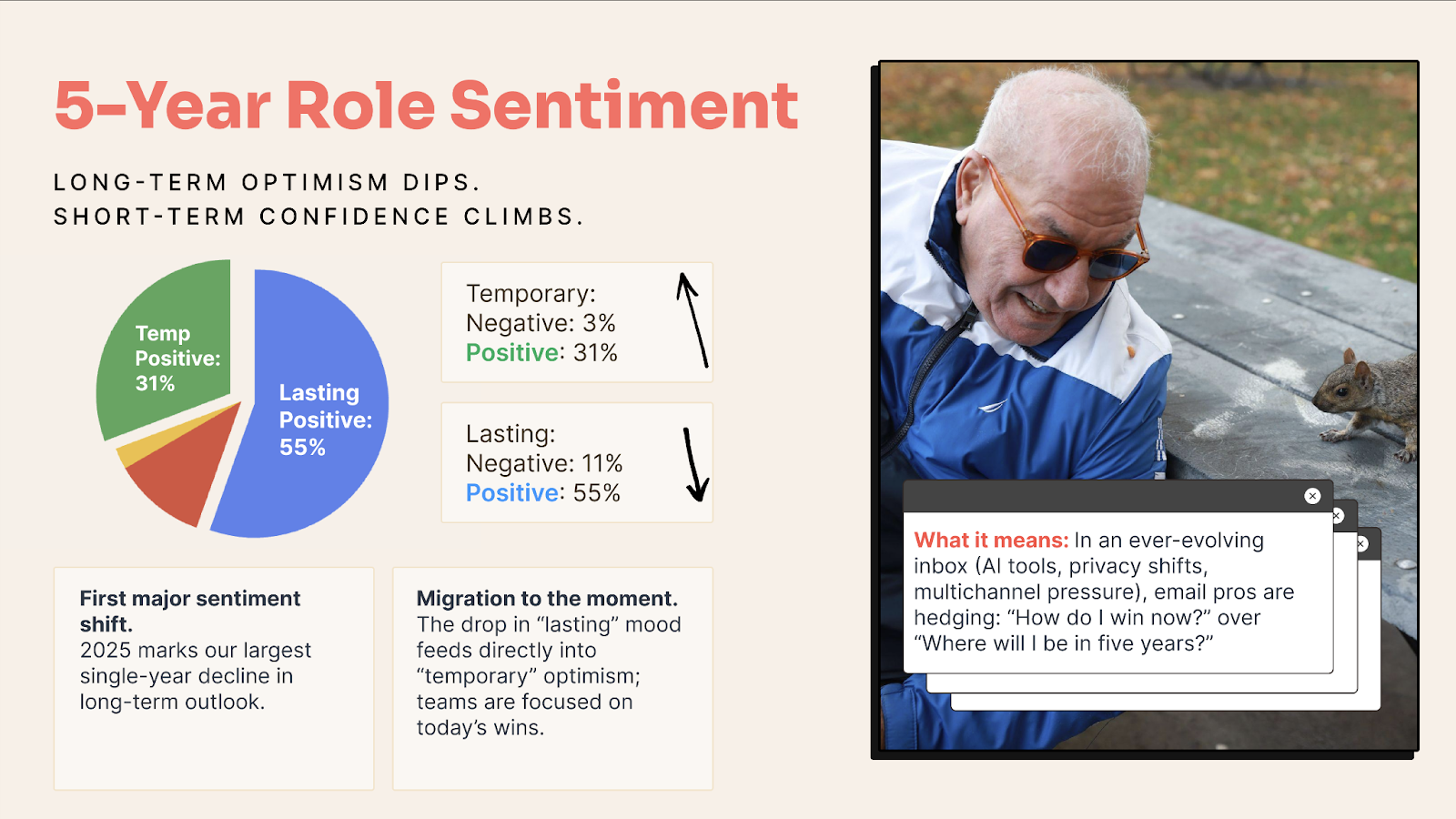
Mike Nelson: Now, here’s something interesting. We talked about this at UNSPAM a few weeks ago. The sentiment. Do you feel like you have a positive outlook on the next few years in email? Five years? Or is it more negative? We’ve been in email a long time, and we know the IKEA effect. The more you build something, the more you love it. We’ve invested a lot in email, so yes, we’re a biased group. But overall, the positive outlook has grown. There has been a shift toward a more temporary optimism, with people saying, “I might move on in a year or two, but for now I still like it.” Still, 55 percent of people have a lasting positive outlook, which is great. Many folks see this as a long-term role.
If you’re joining us and you’re in that group, we love that. We love to see you grow. And no, I wasn’t paid to say that. No one paid me to say I love email. Although I’ve been doing it for a long time. Here’s that trough of sorrows we mentioned. Around year two or three, you start to dip into that "why am I doing this" space. But if you make it past that, things go back up.
Here’s something new we found this year. Sentiment also seems tied to list size. The smaller the company, or rather, the smaller the list size, the more people tend to like the job. You generally enjoy it more. But once you cross over a million subscribers, you start to think, maybe there are other directions to explore. Maybe not email. I found this really interesting. I’m going to just pick on Naomi real quick. Why do you think that is?
Naomi West: When I was in a role managing around 3 million email subscribers, I wanted to quit every single day, and eventually, I did. I left that job and felt so much better afterward. What I found was this deep-rooted attachment from some team members to the list itself. They had been with the company for a long time and were emotionally invested in the subscriber count and the growth they had seen over the past eight years.
No one wanted to talk about list hygiene, ESP migrations, or personalization. We didn’t even have a welcome email. When I suggested one, it felt like a personal attack to some people. I honestly don’t know what was going on. Maybe something was in the water.
I have noticed that when your list size gets that large, it is often paired with outdated tools and an unusual kind of personal attachment. I cannot say this happens everywhere because I have not had another role with a list that size. But that was my experience, and maybe a bit of my trauma, and I hope that is why it felt so difficult.
Mike Nelson: I'm glad I picked on you, Naomi. Now we can work through the trauma together, like a live open therapy session.
Naomi West: Thank you to everyone in the audience for listening to me.
Mike Nelson: I know this sounds a little crazy, but like you said, the tools become more complicated the bigger the brand. The workload increases, and the stress goes up. If you make a mistake, like sending a blank email or one that still says “subject line test,” you feel it more when the list is larger.
With AI now in the mix, there is even more room for error. Maybe you did not read through the copy completely, and it includes something inaccurate. Things move fast. And if you are working for a publicly traded company, that just adds more pressure. Compared to previous years, we are seeing a bigger spike in stress and responsibility.
So, I want to take a moment to acknowledge that. If you are in that group, we see you, appreciate you, and consider you part of this community. If you want to talk more about it, come join us in the Email Geeks Slack channel. If you are looking for a safer space, somewhere around 500,000 subscribers seems to be a sweet spot.
At that level, you are probably the key person on your team. People see you as the one driving conversions and delivering ROI. That often leads to more job security. Compared to 2020, when everything felt unstable, this is a much more solid place to be.
Let’s move on. Your career outlook is not only influenced by how long you have been working in email or how large your list is. It is shaped by both. So here is your five-year forecast.

Mike Nelson: This is also based on what people dislike, but honestly, these pain points have barely changed over the years. Kelsey, I want you to walk us through what these pain points are and why they haven’t evolved much. Has anything new shown up?
Kelsey Yen: Yeah, the biggest pain point continues to be coordinating assets. That has always been a challenge, no matter how big or small your team is. When I worked at a larger company, trying to collect content and forecasts from other teams was really difficult. What did we need to show? Who needed to see it? There were always multiple steps before we could even start building the email.
Even now, there’s still a lot of planning that needs to happen before an email goes out. It is not just a matter of clicking send. So I totally understand why organizing assets remains a top challenge. What’s interesting, though, is that dynamic content has dropped significantly as a reported pain point. I think that's because it's getting easier to be creative and personalized with your messaging. That was a nice trend to see.
Mike Nelson: Yeah, coordinating assets has always been one of the biggest issues, and it's consistently made up around 25 to 30 percent of responses. Now it's sitting at about 20 to 22 percent, so there's a slight dip, but not a big one.
If you're heading back to your team thinking, "Where's that file?" or, "Can we speed up the approval process?"—just know you're not alone. This is still something nearly every team struggles with. How do we solve for that? Well, since it's who I work for, I’ll mention that Beefree can really help here. It has built-in approval processes, central asset storage, and keeps everything in one place. You don’t have to rely solely on your ESP. And that’s as much sales talk as I’ll give during this whole webinar.
The struggle is real. There’s no magic fix. Whatever your challenges are, they will probably still be there tomorrow. But hopefully, someday, you’ll find some freedom from them.
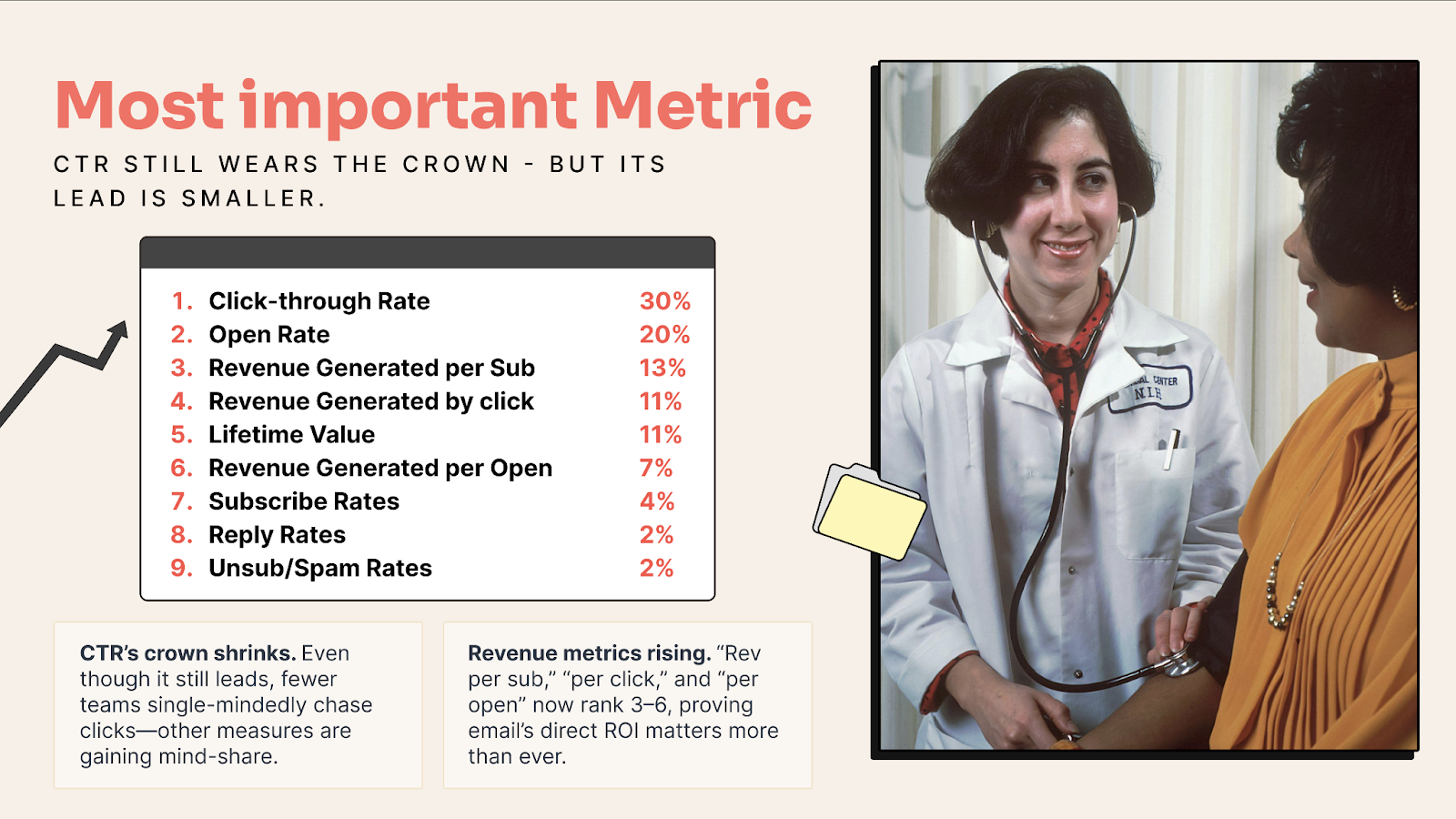
Mike Nelson: Let’s talk about the types of companies represented in the survey. This is just to show that our audience was pretty evenly split between small, medium, and large companies. Here’s how we defined those sizes. When we look at the metrics that matter to each group, you’ll see that click-through rate is the top one at 30 percent. When we first started doing this, open rate used to dominate, sitting at around 50 percent. Everyone focused on it. Back then, revenue-related metrics like revenue per subscriber or lifetime value of a subscriber weren’t even on the radar in 2016 or 2017.
So it’s been impressive to watch those revenue metrics climb the ranks. Now they’re in the number three or four spot. If you combine all the revenue-related metrics, they make up nearly half of the total survey responses. That is a pretty important shift. If you’re going back to your team, this is a key insight. Metrics like open rates and even click-through rates these days are often considered vanity metrics. A lot of companies are starting to move away from those because of issues like click bots skewing the data.
Instead, companies are asking how to justify email in terms of financial impact. How much revenue are we actually generating from it? That might mean starting to look at conversions. How many onsite or on-page sessions happen after someone clicks through from an email? How long are they staying on the site? Are they visiting multiple pages? Are they adding items to their cart? These types of behavioral and transactional signals are going to matter more and more as the year progresses.
Again, the divide between revenue-driven metrics and vanity metrics is clear. If your primary metric is not tied to revenue, there is a good chance your secondary one is not either. On the other hand, companies that are revenue-focused tend to choose another revenue-related metric as their second most important as well. This pattern tells us a lot about the evolving priorities in email marketing. Revenue-related metrics are important too. So, depending on who you work for, this gets interesting. Let’s talk about how this varies by industry. Tylor, Naomi, have you worked in industries outside of SaaS?
Naomi West: I do a lot of consulting in e-commerce and some work with non-profits, which gives me a pretty good range of perspectives and goals to work with.
I think the goals and metrics that matter most to leadership really depend on the organization. In my opinion, it should always come down to conversion goals. What are we actually trying to achieve through the email? Click-through rate is a good indicator of intent, but I personally love looking at conversion rate. I guess that ties into revenue, but in software as a service, the goal is often to get someone to take a series of actions before any revenue is realized, like starting a trial or renewing a subscription.
So while click-through rate is still the go-to email-specific metric I watch, open rates are just too unpredictable these days.
Mike Nelson: That’s a good point. One interesting thing we found is that the travel and leisure industry is the only one where revenue-related metrics ranked higher than clicks or opens. I actually used to work in travel, at Lonely Planet, and it was a very revenue-focused industry. If you look back at companies like Sabre, they were essentially connecting bookings through computer systems before most of the internet existed. In fact, Sabre was building these kinds of systems even before DARPA launched its early internet projects. So travel has been focused on revenue generation since the 1990s.
I also found it interesting that nonprofit organizations and media publications seem to care about almost the same things. That struck me as odd. Don’t both of these sectors rely on revenue in some way? For nonprofits, you’d think the focus would be on donations, fundraising, and driving people to engage meaningfully. For media companies, which I’ve also worked in, the focus is usually on advertising revenue. That includes tracking how many people viewed the content, clicked on ads, and generated engagement through impressions or other metrics.
Still, subscription revenue was only the fourth most important metric. I honestly expected it to rank higher. Maybe there is more emphasis on audience loyalty and engagement than on direct revenue in those cases. We could go deeper on this, but we don’t have all day, so let’s move on.
Now, let’s talk about complications in the workflow. This next insight is a bit wild. Back in 2018, it took an average of five and a half days to create and send an email. As of this year, it’s up to eight and a half days. Let’s pause and unpack that for a second. There’s a big jump between 2022 and 2024. Keep in mind, we skipped 2023 in the data set because Really Good Emails didn’t run the survey that year. Apologies for that gap. But still, the increase is significant. Why do you think this is happening?
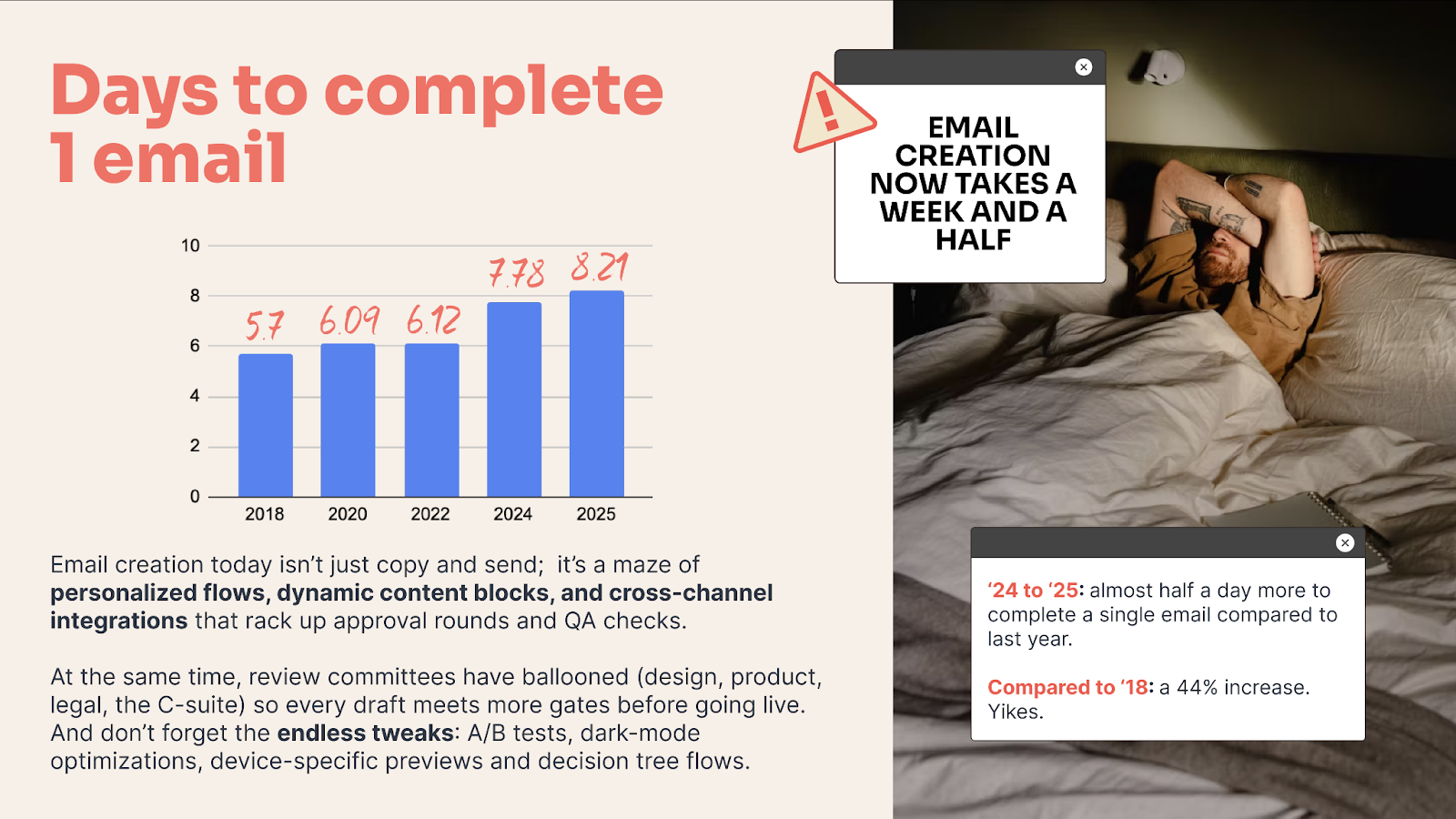
Kelsey Yen: It’s hard to say definitively, because it really depends on your goals, what you’re trying to achieve, and how big your team is. There’s definitely added complexity. Email isn’t easy to create. It takes time, and it’s becoming more complex. There are more possibilities now, with design, code, personalization, and the variety of tools available.
And if you’re on a larger team, that adds even more layers. You have more inputs, more steps in the process, and more approvals to get through. Some people mentioned this in the chat, too. There’s still a perception that email is simple, like you can just write it and send it. But that mindset is outdated. Email may seem easy from the outside, but in reality, it’s quite complicated.
Mike Nelson: All of us on this panel work for software that’s supposed to make email better, yet it's taking longer to create emails. You’d think the time to complete an email would shrink over time, but that hasn’t been the case.
As we discussed earlier, more teams are specializing in certain aspects of email, and that naturally adds layers of complexity. Workflows are more intricate, and decision trees are larger. If you're in lifecycle marketing, like Kelsey and Naomi, you're building out logic like: "If a person does this, then what happens next?" Back in 2018, it was more like, "Let’s just send the email" and move on.
That approach doesn’t work anymore. Now, we’re dealing with detailed approval processes, strict brand guidelines, and making sure every message aligns with a brand's sound and look. All of that contributes to longer production cycles. This increasing complexity is a challenge for the industry. If email production continues to take more time, that’s not sustainable. So, what can we do to reduce production time?
From what we’ve seen in the AI data, teams using AI tools are cutting their timelines significantly—sometimes by nearly half. Teams that rely on templates, modular layouts, saved content blocks, and clearly defined brand guidelines also work faster. Having that structure in place makes a big difference. Better planning helps, too. The more organized you are up front, the smoother the execution phase will be. Whether it’s smarter tools or stronger preparation, there are definitely ways to streamline the process.
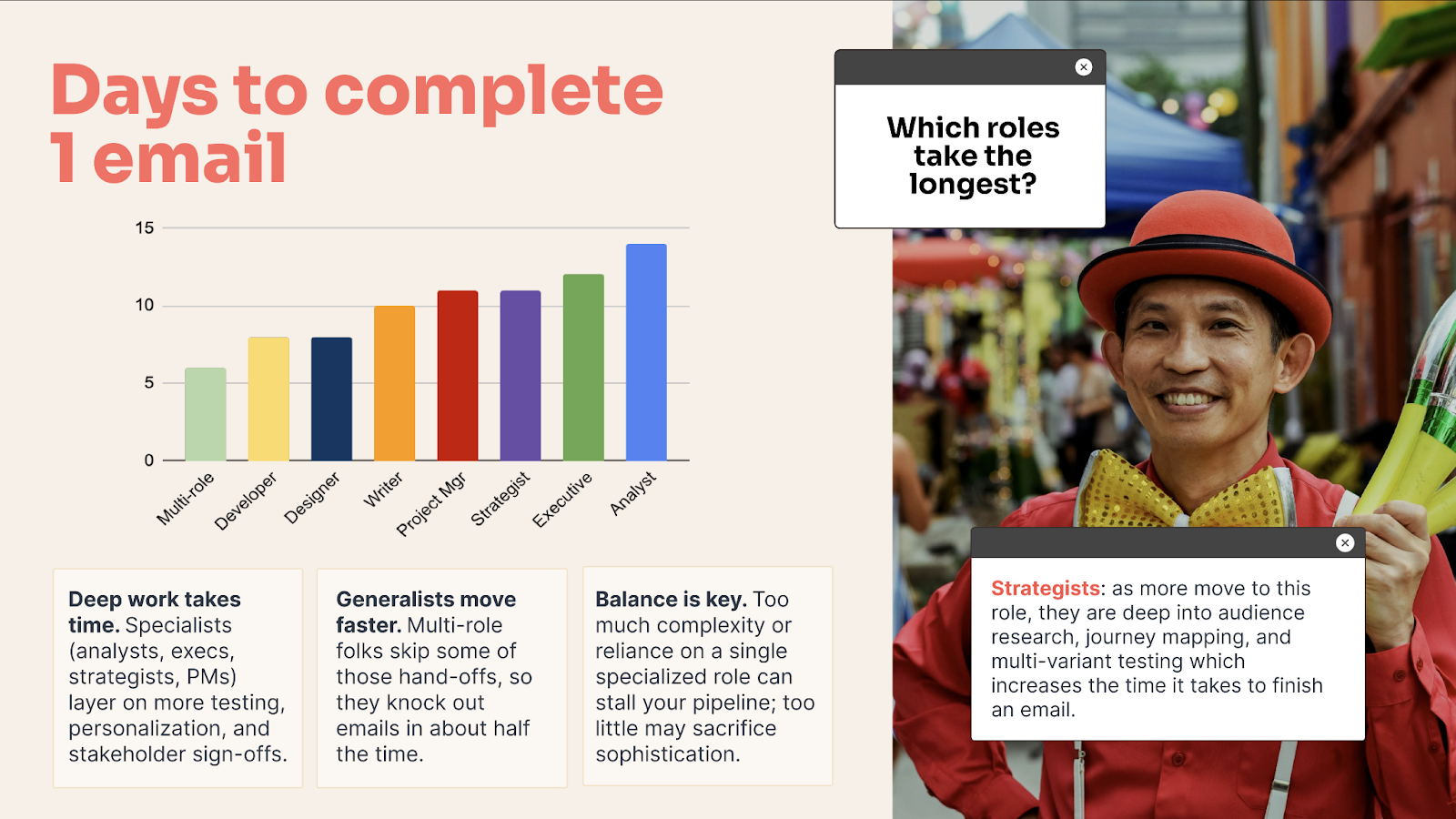
Mike Nelson: Now, let’s talk about who is spending the most time on email. This doesn't always mean the person actually creating the email. It could be contributors or people involved in approvals and strategy. What’s interesting is that generalists or people wearing multiple hats tend to spend the least amount of time on a single email. These are often folks at smaller companies or agencies who handle one part of the process and then move on. They simply don’t have the time or resources to spend 10 days on a campaign, and it shows.
On the higher end, the roles that take the most time are executives, analysts, and strategists. I’ve been in those roles before, where you’re managing multiple campaigns at once, trying to fit everything into a bigger strategy. You might be handling different markets — English, French, Italian, and more. Naomi’s based in Canada, so she’s probably dealing with both English and French content. Larger companies come with more complexity. Bigger teams mean more roles, and more roles mean more steps in the process. It’s not surprising that the more enterprise-level the company, the more time it takes to complete an email.
Tylor, is there anything that stands out to you in all of this?
Tylor Loposser: Yeah, I think part of it comes down to finding better ways to organize people and make sure everyone is on the same page. Earlier, we were talking about things we could do to improve. One thing we brought back was the standup meeting. It’s something that used to be common in traditional in-office culture, but even with our team spread across multiple time zones, we’ve made it work. These are biweekly check-ins, just 15 minutes long, and they’ve had a big impact. They make sure everyone is aligned and focused on the right tasks, and they’ve really helped improve how efficiently we move projects forward.
These quick meetings also give people a chance to raise blockers — to say what’s stopping them from finishing their work on time. That space for communication has been incredibly valuable. So really, creating a consistent space for communication has helped us a lot. It has made a noticeable difference in reducing the time it takes to complete an email. Honestly, we were exceeding the average numbers shown in the data, so this has been a major step in helping us move faster.
Mike Nelson: Awesome. So, communication is key.
The average time to create an email is now about four and a half days, depending on the size of your company. We'll share these slides with everyone after the session. Looking at the data from last year to this year, there's been an increase of about half a day. When we did the math—or "maths" for those across the pond—that adds up to roughly 18 extra days per year spent on email production. Think about what you could do with an extra two to three weeks of work. That time adds up. So it's worth identifying areas where you can work more efficiently and reduce opportunity costs. Improving communication is one way. Another is using templates, saved rows, or clearly defined brand guidelines to speed up production.
Email has never been easy, and it's only getting more complex. Now let's talk tools. We’ll go through this quickly. These are not endorsements, but a look at the most commonly used ESPs based on the best reported results by company size. For small companies, Klaviyo leads the pack at 30 percent this year, up from 25 percent last year and 14 percent in 2022. That’s a huge jump, mostly driven by e-commerce businesses.
For medium-sized companies, the top tools are Salesforce, Klaviyo, and HubSpot. For large companies, it's Salesforce, Adobe, and Emarsys. Also worth noting: 64 percent of respondents said they supplement their ESP with an additional tool. This makes sense. No single ESP can do everything you need. For example, you might use Parcel in combination with Customer.io, even though they’re under the same parent company. You might also use Really Good Emails or Beefree to streamline content creation.
Some larger ESPs even incorporate the Beefree SDK into their platforms, offering drag-and-drop email builders. This isn’t surprising. The larger your program, the more likely you are to use other tools alongside it. What stood out to me is that enterprise-level ESPs are the most likely to use extra tools. This reflects the growing complexity of their programs, the different data models they work with, and the higher expectations placed on them.
Larger companies are more likely to supplement—76 percent do—compared to smaller businesses, which may have tighter budgets or fewer technical needs. But generally, when you look at tools, specifically ESPs and not adjacent platforms, the average rating they received was 6 out of 10. When we calculated the Net Promoter Score (NPS), it came out to a negative 22. If you're in the ESP space, that’s not something you want to report to your CEO and say, “Hey, the community doesn’t think we’re doing great.”
There is clearly a lot of room for improvement, whether you’re building an ESP or a supporting tool that works alongside one. For anyone in this audience working on a SaaS product that supports email, we’re all trying to improve things. The goal is to make email more efficient, more effective, and faster to produce.
No ESP is perfect, and none should claim to be. The data just doesn’t support that. However, there are tools that can improve your workflow when used alongside your ESP. This is where I give a quick nod to Beefree. If you need a great email builder, you know where to find us. Just putting that out there. Alright, let’s move on.
Now let’s get into design. Here’s a quick look at some of the current design trends. This section comes from Tylor, and Naomi also did a great job unpacking it during Unspam. Tylor, I think these examples are yours. Let’s start with “doodles over images.” Can you walk us through why this has become a trend over the past year?
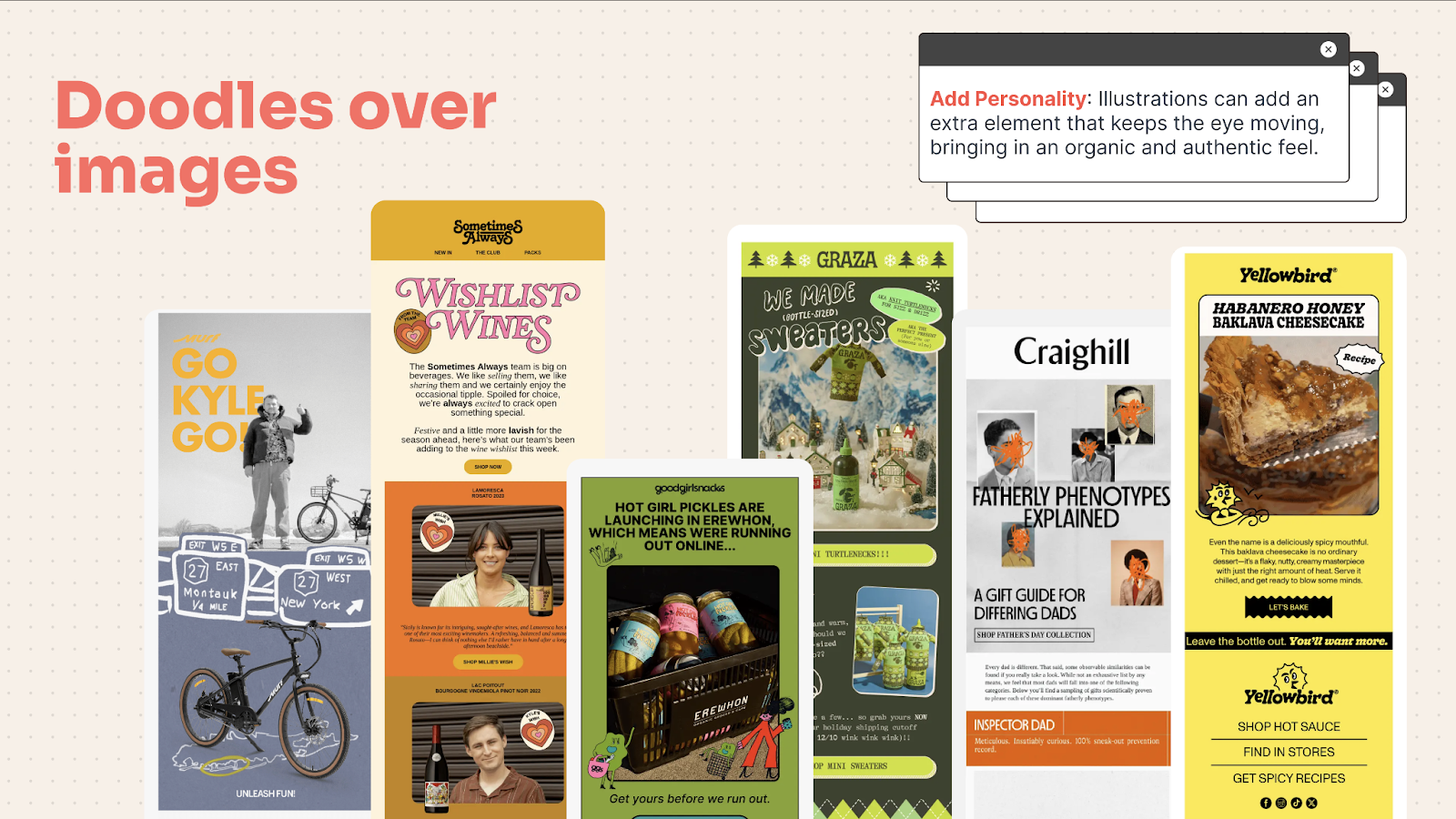
Tylor Loposser: I think a lot of what you mentioned earlier is relevant here. At a certain point, either the designer or the brand can start to feel a bit stale and want to bring more human elements into their email designs. Doodles over images really highlight that opportunity. It gives the one designer on your team the chance to draw something original and layer it over product shots or high-quality photography.
This kind of mismatched style opens the door for experimentation and creativity. It’s especially valuable during times when both the audience and the designers feel like everything out there is starting to look the same or feels generated by AI.
Personally, I think this trend is fantastic. People seem to be responding to it really well. I’d encourage brands to incorporate a sketched or handwritten element into their brand guidelines. It can add a personal and unique touch to your marketing.
Mike Nelson: The next one is comfort-driven design.
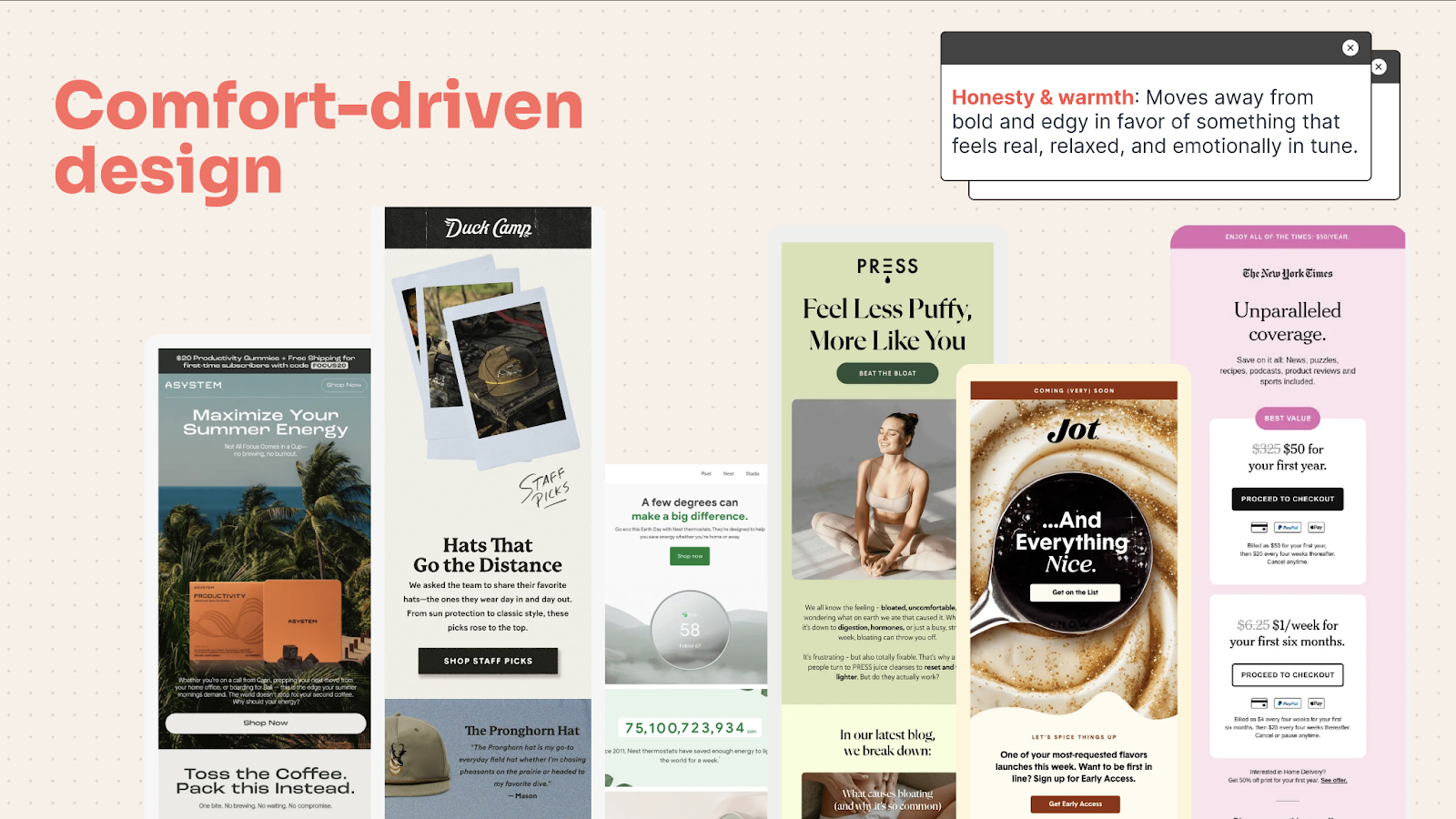
Tylor Loposser: Right. When people feel overwhelmed—whether that’s inside the company, through the work they're doing, or because of the world around them—they’re often looking for something softer and more comforting. And brands are responding to that.
We’re seeing shifts in color palettes, more use of soft lines, gentler typography, and layouts that embrace vertical scrolling. There’s less pressure to get people to click right away. Instead, the goal is to let them move through the email at their own pace, scroll down, and enjoy the content. You can see this in the spacing between lines, the use of vertical imagery, and the overall relaxed tone. It invites readers to slow down and absorb the message in a more comfortable way. It really feels like a reflection of the time we’re living in.
Mike Nelson: What I also love is how we’re shifting from sharp edges to softer, rounded corners. That makes the design feel more approachable and easier on the eyes. And then there's what I’ve been calling “darker mode.” It’s not just traditional dark mode with black backgrounds. It's a broader range of deeper tones that feel more nuanced.
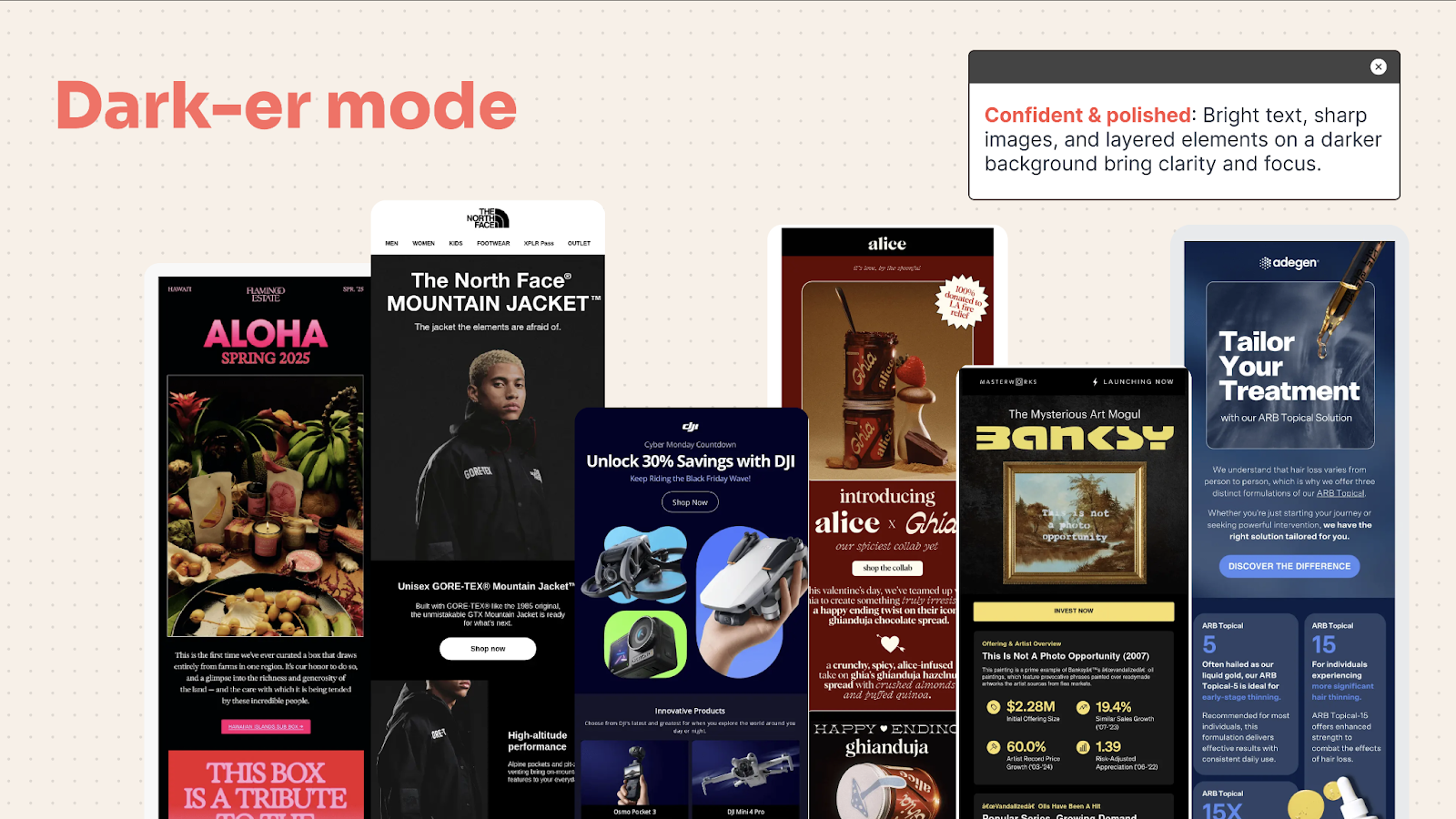
Tylor Loposser: Exactly. I think this trend is a big win for accessibility. It's also smart when you consider that almost 50 percent of people view emails in dark mode. So why not start there?
It might also reflect the current mood. Maybe we’re all feeling a bit heavy right now, and that energy naturally shows up in our design choices. Still, the result is often something visually striking. It's a strong trend that makes a lot of sense.
Mike Nelson: That ties nicely into Naomi’s point. Someone just asked about simple text-only emails. Naomi, how do you see those fitting in compared to other design styles?
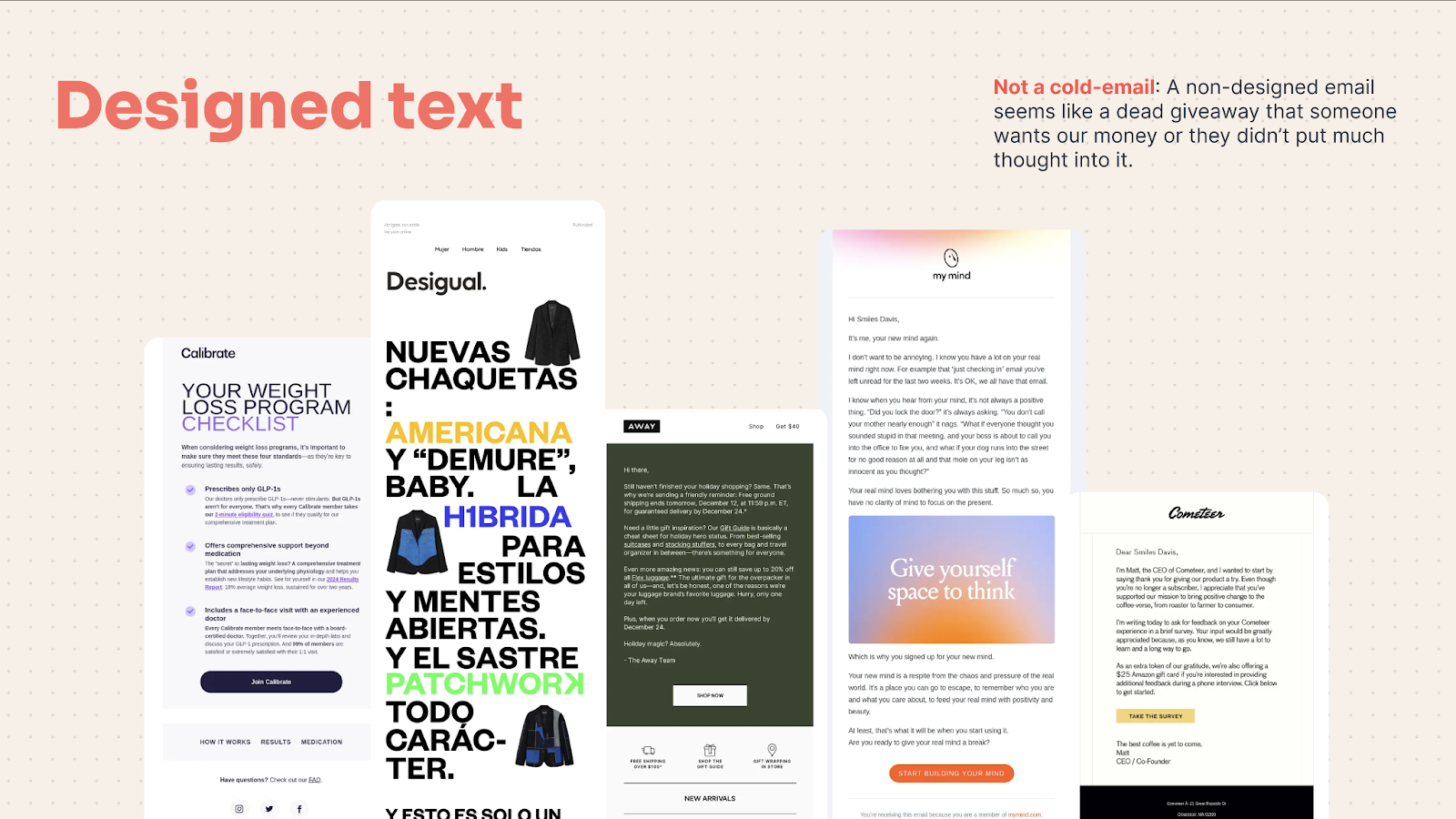
Naomi West: I actually gave a full talk on this over on the Really Good Emails YouTube channel. For some reason, I’m really into text-based emails. I’ve found they have a much shorter production timeline. I can just ask, “Does this copy look good?” and if the answer is yes, that email is ready in a day. That’s a huge contrast to the 10 to 15 days it can take to create a more elaborate design.
When we hired Mark Robbins at Parcel, who is incredibly skilled at HTML and email code, I was excited. I thought he could bring some flair to my plain text emails. We ran an A/B test between a nicely designed version and my basic text-based “Welcome to Parcel” email. Surprisingly, or maybe not, the plain version had better results. It not only had a higher click-through rate, but also significantly more conversions. I think that’s because, in a sea of polished emails, something simple and straightforward can really stand out. It makes taking action easier.
I could go on about this for a while, but the takeaway is simple. Clean, no-frills emails still work. You just have to test them and see what your audience responds to.
Mike Nelson: For me, when I get a text-based email after scrolling through 70 visually complex, highly designed brand emails, it actually makes me pause and think, "This one might be important." It stands out. It feels different from plain text, where it's just raw copy without any structure or styling. These text-based emails still include subtle branding touches. You might see brand colors, a clean layout, and strong typography. It’s minimal, but it still reinforces the brand clearly and effectively.
Naomi’s full talk from Unspam is available on our YouTube channel. It’s well worth watching. Tylor also has a great session on design trends from the same event. We only scratched the surface today, but those talks go much deeper into what’s happening in email design right now. Think of this as a quick preview to spark your curiosity.
In the last few minutes, we touched on AI. Last year, 78 percent of people said AI was not the future and didn’t seem relevant to their work. This year, 66 percent said it is already having a big impact. We’ve already seen a drop in the number of dedicated copywriters, which may be a sign of that shift. Teams that use AI to generate copy ideas, campaign strategies, or subject lines are creating emails more quickly. AI copilots are helping streamline production, even if they are not perfect yet.
There are still challenges. AI tools struggle with the technical requirements of email, especially responsive design across screen sizes. Anton, who is in the audience and spoke at Unspam, covered many of those limitations in detail. Still, many people are starting to lean into AI. A 144-point swing in perception is a strong signal. If you haven’t started using it, try experimenting in small ways. Don’t ask it to code and send an entire email right away. Start by asking it to review your content, suggest improvements, or rewrite for different personas. You can even ask it questions like, “What’s unclear here?” or “How would you make this funnier?”
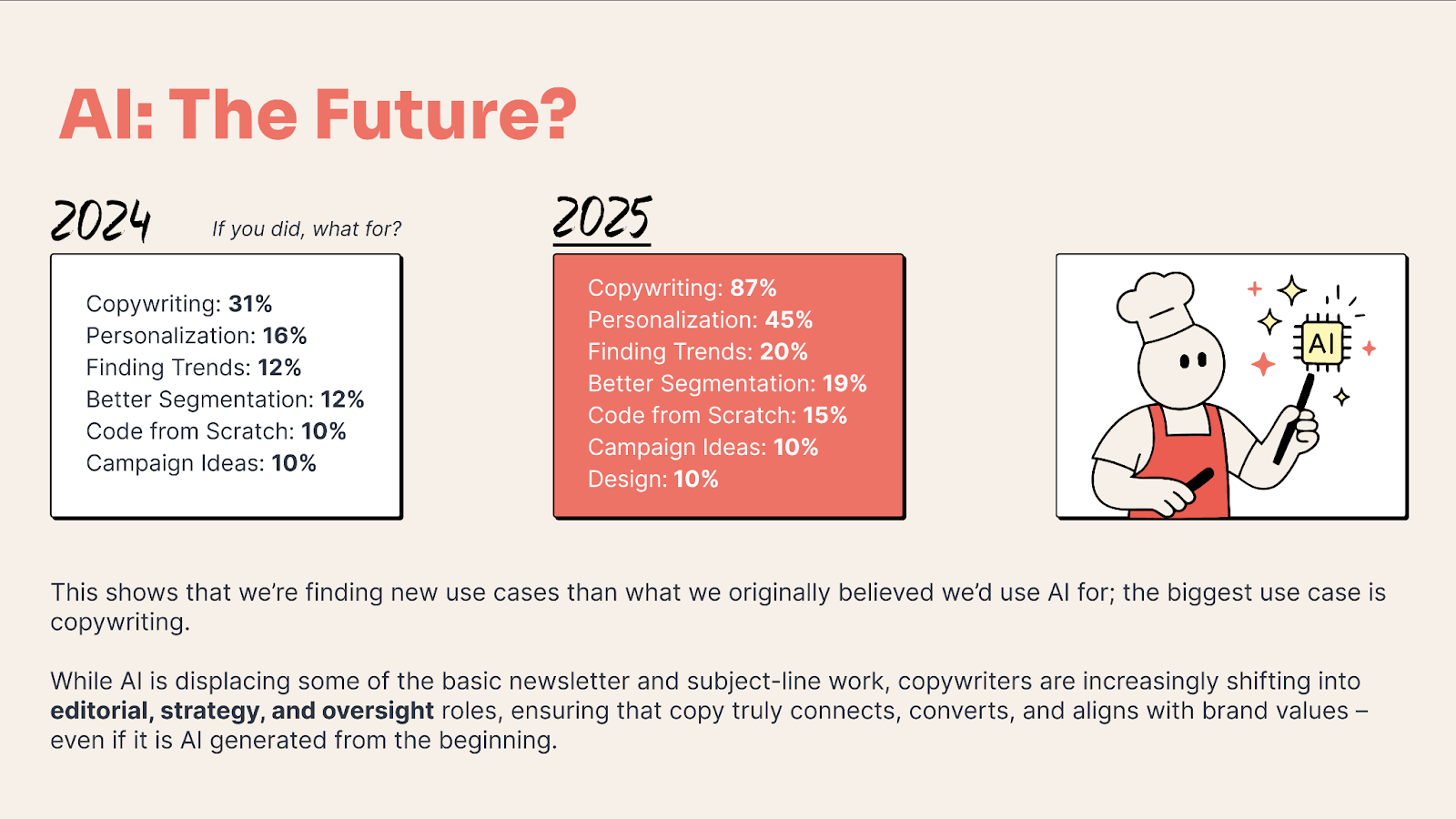
Mike Nelson: On our team, we’ve begun using AI to brainstorm. I’ve been writing the Really Good Emails newsletter since 2015 and have sent over a thousand editions. After that, sometimes I run out of ideas. AI helps spark fresh directions. Hopefully, they’re good ones. Or maybe you’re thinking, “These are terrible, Mike. We don’t even read them.” Here's what people expected to use AI for back in 2024, compared to how they're actually using it today. The biggest change was in copywriting. Around 30 percent predicted they would use it for writing content. Today, almost everyone is using it for that purpose.
The structure of tools like ChatGPT and Claude really lends itself well to copywriting and content revisions. Last year, only about 16% of respondents saw personalization as a key use case. Now, that number is closer to 45%. Trend analysis also grew, with 20% of people now using AI for that. Interestingly, back in 2024, no one mentioned using AI for design. But with better models now available—tools that can remove backgrounds, combine product images, or generate design elements—that's changing. Design is starting to be part of the workflow for about 10% of respondents. I imagine this number will climb quickly, especially as newer models like ChatGPT-4 and Midjourney’s latest versions mature. The survey results came in before those models were widely released, so the growth in design-related use is only just beginning.
Now, why are some people still not using AI? About a third cited reasons like lack of time, limited resources, or internal policies. Legal or compliance teams may not approve. Others struggle to get AI to match their brand voice, or they worry AI might eventually replace them. All of those concerns are valid. If you’re not using AI yet, or can’t, you’re not alone—and we’re not here to shame you. We hear you, and we get it. Everything we’ve shared here today is available in a downloadable summary. You can share it with your team, and if you want to contribute, you can upload your own work to Really Good Emails. If you have questions, we’re here with answers.
Let’s take a few more minutes to jump into the Q&A. If everyone is okay with it, we’ll go five minutes over.
Q: “How relevant is interactive email marketing, such as polls, reviews, gamification, or lead generation? Do you have any platform recommendations?”
Naomi West: That’s a big question. Honestly, each of those use cases could be their own topic. Polls, for instance, are fairly easy to implement without complex tools. You can embed clickable links in your email and use click retargeting to track how people respond. It doesn’t require heavy coding or external software.
Gamification and lead gen are broader topics. Lead gen is fundamental to growing your list and your business, especially if you’re running referral programs. For gamification, one platform I see used frequently is NiftyImages. We use it in the Really Good Emails newsletter, and every time I see my name personalized in the hero image, it feels special. I love that kind of interaction.
Tylor Loposser: I’m not overly positive about it, to be honest. Interactive emails often feel more like a gimmick than something that really works for most audiences. One of the biggest challenges is accessibility. We still have a long way to go when it comes to making emails inclusive, and interactive elements can be a major barrier. They’re a creative way to grab attention or push a product, but they often feel like a one-off experience rather than something that truly drives results.
I’m not convinced interactive emails are actually moving the needle in a meaningful way.
Mike Nelson: I agree, especially from an accessibility standpoint. If someone has images turned off or relies on a screen reader, interacting with these emails can be nearly impossible. That’s a serious issue. At Really Good Emails, we use a super simple poll at the end of our newsletter. It just says, "Reply with your answer." That might seem basic, but it actually improves our deliverability. The more replies we get, the more likely it is that our next email lands in the inbox.
Plus, I get to have great conversations with people who read the newsletter. It opens up opportunities for real engagement, even if someone didn’t click through an article or a video. It’s a small thing, but it creates a genuine connection.
We’re at the time now, so I want to thank everyone for joining. I really appreciate you spending an hour and six minutes with us. If you joined right at the start, you know we kicked things off promptly.
Tylor and Naomi, as always, it’s a pleasure. Thank you both for speaking at Unspam and for participating in this session today. It’s always great to see your faces.
Kelsey, thank you again for joining me, even though I keep roping you into these things you may or may not have signed up for. I appreciate you.
And to everyone out there, thank you for showing up. We’ll see you in Email Geeks and in your inboxes. Feel free to reply to the Really Good Emails newsletter — I’m Mike from Really Good Emails, and I’d love to hear from you. Thanks again. Bye, everyone!
